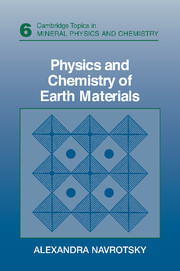Book contents
- Frontmatter
- Contents
- Acknowledgments
- 1 Introduction
- 2 Crystal chemistry
- 3 Experimental methods for studying structure
- 4 Methods for studying thermodynamic properties
- 5 Chemical bonding
- 6 Mineral thermodynamics
- 7 Solid solutions and order–disorder
- 8 Melts, glasses, and amorphous materials
- 9 The interface between mineral physics and materials science
- Index
9 - The interface between mineral physics and materials science
Published online by Cambridge University Press: 05 June 2012
- Frontmatter
- Contents
- Acknowledgments
- 1 Introduction
- 2 Crystal chemistry
- 3 Experimental methods for studying structure
- 4 Methods for studying thermodynamic properties
- 5 Chemical bonding
- 6 Mineral thermodynamics
- 7 Solid solutions and order–disorder
- 8 Melts, glasses, and amorphous materials
- 9 The interface between mineral physics and materials science
- Index
Summary
Scientific issues
Art imitates nature and nature imitates art. The Earth is a materials-processing laboratory operating with time, distance, mass, pressure, and temperature on a grand scale. From brittle fracture in the crust to convection in the core, geologic process reflects the materials properties of natural, largely inorganic materials, namely, rocks, and the fluids that permeate them. If several kilometers of the San Andreas Fault slip a few meters relative to each other during a devastating earthquake, the movement involves, on a microscopic scale, the breaking of chemical bonds in silicate minerals. The excitement of modern Earth sciences comes from this interplay of microscopic and macroscopic phenomena, the revolution in instrumentation for laboratory, computational, and field studies, and the flood of new data on all scales.
Rock mechanics and motion
Cold rocks near the Earth's surface deform by brittle failure, hot rocks at greater depth by plastic flow. In both cases, defect chemistry, dislocations, and other microscopic phenomena form the basis for macroscopic movement. Understanding stress–strain relationships, crack propagation, and the effect of fluids on strength are fundamental to understanding faulting and earthquakes. Plastic flow in the mantle makes that region fluid on the geologic time scale; thus geophysicists can speak of mantle convection without invoking large volumes of conventionally molten rock. Because most minerals are multicomponent solid solutions, their defect equilibria are usually extrinsic and often dominated by the oxidation–reduction reactions of iron.
- Type
- Chapter
- Information
- Physics and Chemistry of Earth Materials , pp. 408 - 414Publisher: Cambridge University PressPrint publication year: 1994

